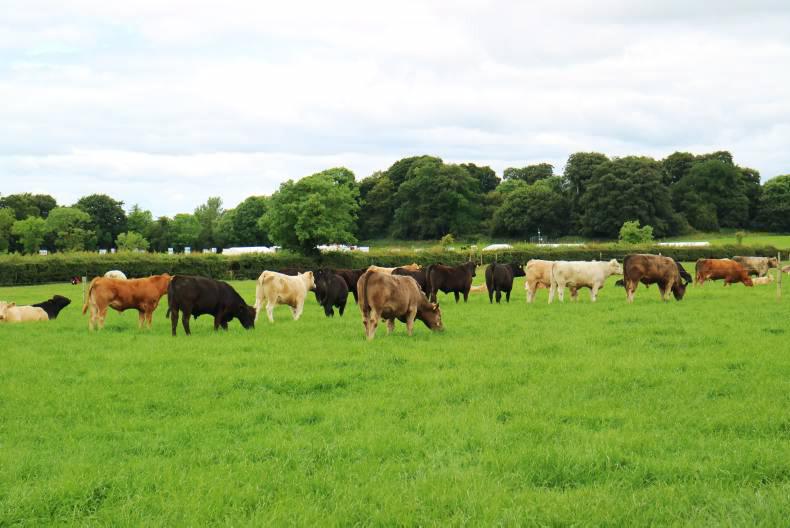The event, with a theme of profitable technologies, is showcasing the heights that can be achieved when beef farms are pushed close to their potential.
There are five technical stands on the site, followed by a series of villages.
At stand one, researchers Adam Woods and Paul Crosson outline the key profit drivers in beef systems: grass utilisation, maximising animal performance and increasing stocking rate. James Keane then puts raw figures on what improvements in efficiency can do to the bottom line.
He says that utilising an extra tonne of grass per hectare increases the overall farm net margin by €105, calving heifers at 24 months leads to a €112 increase and getting an extra 0.1kg of daily LWG on calves gives a €78 increase.
Paul Crossan’s message is clear that efficiency should be improved before thinking of increasing stocking rate – “skill not scale”.
Dairy calf-to-beef systems
Stand two sees researcher Rob Prendiville and adviser Gordon Pepperd cover dairy calf-to-beef systems. A 21-month early-maturing (Angus/Hereford) -cross dairy calf system was found to be the most profitable. This involves a spring calf put through a store winter and finished from grass in the back-end. On a 40ha farm, it produced a net margin of €32,760.
Gordon stresses that calf health, calf price and stocking rate are key drivers of success in the system, as are meal price and beef price.
Genetics
Chris Daily (ICBF) and Nóirín McHugh (Teagasc) cover genetics at stand three, with topics including the type of data feeding into ICBF, the weighting for different traits in an animal’s index value and what causes the indices to change.
Nóirín McHugh and Chris Daly on using the breeding indexes to improve herd performance #BEEF2016 pic.twitter.com/WwwS2Pd7GU
— FJ Beef (@FJBeef) July 5, 2016
“Do the indices work?” is a question from the crowd.
Chris Daly answers by showing how the average five-star cow leaves behind an extra €172 per lactation when compared with a one-star cow. The improvement in profitability comes through the animal calving younger (66 days), going back in calf quicker (-7 days), having a heavier calf at weaning (30kg) and greater survivability.
Grassland management
At stand four, Pearse Kelly and Michael O’Donovan from Teagasc cover grassland management. They give an outline of the four steps to improving grass growth an utilisation on farm and stress that things might go belly-up if the steps are not followed in the correct order:
1. Improving soil fertility – soil testing and taking action to correct deficient fields.
2. Investing in grazing infrastructure – paddock fencing, drinkers and roadways.
3. Measuring and managing grass – taking weekly farm measurements and correcting grass surpluses (removing paddocks) and deficits (supplementation, increasing fertiliser usage and rehousing).
4. Incorporating more perennial ryegrass and clover into the farm system – reseeding.
At the final technical stand, researcher David Kenny talks fertility. He gives an update of the national fertility averages and it makes for painful listening: 17 cows in every hundred produce no calf in a given year (target 100/100), cows only calving every 407 days (target 365) and 32 months being the average age at first calving (target 24 months).
90% of Irish fields have suboptimal soil fertility. Here's what correcting pH alone (lime) will do...#BEEF2016 pic.twitter.com/zZypYKfMag
— FJ Beef (@FJBeef) July 5, 2016
David says that farmers must focus on cow BCS at breeding and calving to improve these figures, as well as hitting weight targets with replacement heifers at breeding (400kg at 15 months) and checking bull fertility in a natural service system. He encourages the use of AI breeding – access to the very best genetics should be grasped with both hands – and cites synchronisation as a way around laborious heat detection.
Brexit discussion dominates Beef 2016
Welcome to Beef 2016, the Teagasc national beef open day, by Teagasc director Prof Gerry Boyle
Beef 2016: what’s on at the main stands?
Beef 2016: what’s on in the villages






 This is a subscriber-only article
This is a subscriber-only article











SHARING OPTIONS: